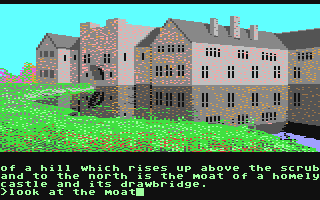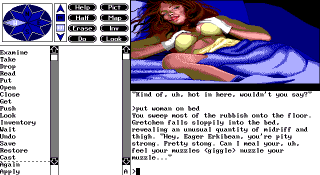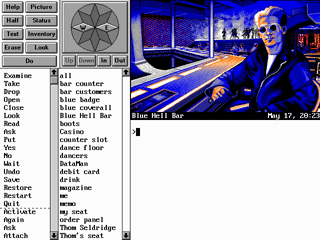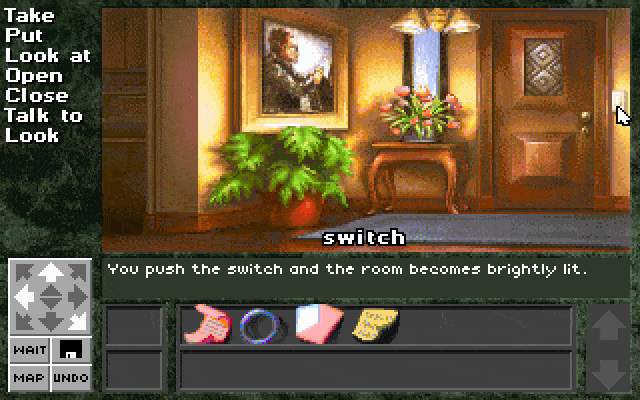Why call them that instead of Graphical Adventure or the like? Because, as I noted, they're an in-between point. They had text adventure style inputs (and later early Point n Click interfaces), or collections of parser you could click on, and graphics. Here, let me show you an early example: Shadowgate. Notice the differences between that and, say, Maniac Mansion (released between this game, and the Atari STE game I'll mention next, in 1987)
Hit self: You die. Open door: You die.
While it's not the earliest example (that would be Deja Vu: A Nightmare Comes True, by the same company, ICOM Simulations), you can see many of the features of the prototypical graphic parse- What? You think it's an RPG? No, 'fraid not. There are no HP in this game, just a series of "You did the wrong thing and died horribly." No, really, there's a lot of that in this damn game. Going into the wrong door at the wrong time could kill you!
But we're not here to talk about the foibles of earlier designers, who often conflated "Dick move" with "Challenge" and "Replayability" because they didn't know better... So let's see... We have an EXITS doohickey we can click in the bottom left (useful, because often we can't look around), A set of verbs, an inventory, a self button, spells, and... Wait, what do we click on?
Ah, here's the "beauty" of these experiments. The items are actually on screen, and that's what you click! Shadowgate, as one of the earliest, actually suffered for this. Good example, under this carpet, or one very much like it, there is an item. The only way to tell this item is even there (and you need it) is to pixel hunt. What's that? Well, nowadays, most of the irritation is finding a small area you can click on to do a thing, mostly because of glitchy context sensitive controls in the games that have those. In older games, with a smaller screen size (Go look up EGA limits to get some idea of how big this would have been, at its best... Or perhaps CGA, for extra magenta funtimes!), the thing you could click on could be as small as... A single pixel. In among, at the time, anything up to 307,200 on the screen (or less, like Shadowgate)
Now you know why I'm a grouchy old sod about games sometimes... Because I grew up with this shit.
In any case, Shadowgate didn't have a great story, but other experiments happened around the same time as ICON's games. Here's Wonderland, as you would see it on an Atari ST.
And this screen, like others in the series, was ANIMATED too!
Pretty neat, huh? No? Well, consider that, at the time the Atari STE came out, you had... Er... GEM. Not even Windows 3.1. Fucking GEM. And these windows you're seeing? They aren't the Atari ST's Little Green Desktop (AKA Crystal, the precursor to GEM), they're a system that's part of the game itself. And all of these windows are resizable, movable, and can be closed out if need be. Of course, not every system got something this sweet. Here's Guild of Thieves on the C64.
Nary a window to be seen.
Not as cool, is it? In fact, apart from the well drawn pixel art (considering the limitations of the system), it's no different from, say... Twin Kingdom Valley, or Questprobe's Marvel graphical text adventures... Where, on most platforms they came out on, you had to specifically request the drawing, and it would look... Well...
You see a cabin in the woods. It is where you put treasure.
...About like that. But like their ICON contemporaries, the Magnetic Scrolls adventure games had a selectable parser. You could, if you were somehow in possession of an Atari ST without a working keyboard (Not completely uncommon, but relatively easy to fix), you could click on a VERB or COMMAND menu, then something either in the room, or in your inventory. It had separate windows for both, with pretty icons. In this way, the Magnetic Scrolls games beat the metaphorical tar out of their compatriots. So let's look at the final compatriot, which did one thing both ICON and the Magnetic Scrolls games didn't quite manage.
Legend Entertainment released their first game in 1990. It was... Er...
Hoo, boy... This is awkward.
...This, Spellcasting 101. If you guessed from this screenshot that the series (for lo, they made three of them!) was on par, writing and tone wise, with Leisure Suit Larry... You'd be quite right. But, regardless of my opinion of the game (Slightly embarassed it exists, thanks for asking), it nonetheless belongs to the subgenre, and Legend (With chief writer and ex-Infocom staffer Steve Meretzky at the helm most of the company's life) went on to better things. Mostly better, anyhoo. Fast forward two years, and you have their first tie-in (A thing they became famous for) ...
Know what impresses me? That item list!
...Frederik Pohl's Gateway. Based on the science fiction series of the same name (And, not oddly at all, the same author), the game was... Actually critically lambasted for feeling out of date, design wise. But suffice to say, it now has quite a cult following, as do Legend in general and Steve Meretzky. Sadly, the sequel to this game (also panned) was the last gasp of the subgenre in the mainstream, and after this, Legend went on to make first person graphical adventure games, with the mostly familiar elements you'd expect. And so history trundled on. But Legend pretty much thrived in this field, whereas ICON and the MS team... Didn't really.
Companions of Xanth: Not Legend's greatest achievement. That would be Callahan's Crosstime Saloon.







No comments:
Post a Comment